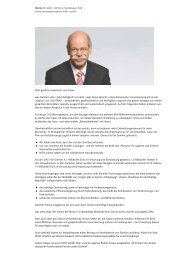Dear readers, This report describes what Daimler means by ...
Dear readers, This report describes what Daimler means by ...
Dear readers, This report describes what Daimler means by ...
You also want an ePaper? Increase the reach of your titles
YUMPU automatically turns print PDFs into web optimized ePapers that Google loves.
<strong>Daimler</strong> 360 GRAD - FAKTEN zur Nachhaltigkeit 2008<br />
<strong>Daimler</strong> Nachhaltigkeitsbericht 2008 / Environmental protection, innovation, and safety / Production / Energy and climate protection<br />
Energy and climate protection<br />
Direct and indirect CO 2 emissions from production<br />
To reduce energy consumption at its plants, and thus CO 2 emissions, <strong>Daimler</strong> employs a dual approach that calls<br />
not only for ensuring the most environmentally sound energy supply processes possible for the production<br />
plants, but also efficient use of energy in production. The Group’s production locations are heated with natural<br />
gas, which is a low-carbon energy carrier, for example, and one plant uses shredded waste wood to achieve<br />
nearly CO 2 - free heating. Coke is used only where technologically necessary, which <strong>means</strong> for smelting cast iron.<br />
Many production plants are supplied with heat and power <strong>by</strong> highly efficient cogeneration plants operated either<br />
<strong>by</strong> <strong>Daimler</strong> or <strong>by</strong> regional power companies. For its new construction, expansion, and modernization projects,<br />
<strong>Daimler</strong> makes use of innovative low-CO 2 energy supply concepts and electricity generated from renewable<br />
sources. A new photovoltaic system at the Gaggenau plant, for instance, and existing photovoltaic facilities in<br />
Bad Cannstatt (Untertürkheim) and Sindelfingen (MTC Design building) regeneratively produced nearly 900<br />
megawatt-hours of electricity in 2007.<br />
<strong>Daimler</strong>’s worldwide energy consumption totaled 10.2 million megawatt-hours in 2007, a decrease of 5.2<br />
percent from the previous year. Along with generally mild weather, this reduction was mainly due to<br />
improvements in energy efficiency brought about <strong>by</strong> many energy-saving projects at our production plants. One<br />
outstanding example of our energy-saving achievements is offered <strong>by</strong> our Untertürkheim plant. Here, a facilitywide<br />
interdisciplinary project team set itself the goal of exploiting all possibilities for reducing energy<br />
consumption in areas as diverse as machine and facility planning, production infrastructure, and building<br />
systems, while also addressing the impact of employee behavior on energy use. The team approved and<br />
implemented a wide range of measures that proved very successful:<br />
� Raising the temperature of cooling lubricants cut the annual electricity consumption of refrigeration<br />
machinery <strong>by</strong> 15,000 megawatt-hours, without any detrimental effect on production quality. <strong>This</strong> same<br />
measure also significantly reduced cooling-water consumption.<br />
� Optimization of heat recovery equipment <strong>by</strong> <strong>means</strong> of improved controls, adjustments in line with<br />
requirements, and use of alternative heat sources led to annual heat energy savings of 11,000<br />
megawatthours. Current plans call for further heat recovery savings totaling 18,000 megawatt-hours.














